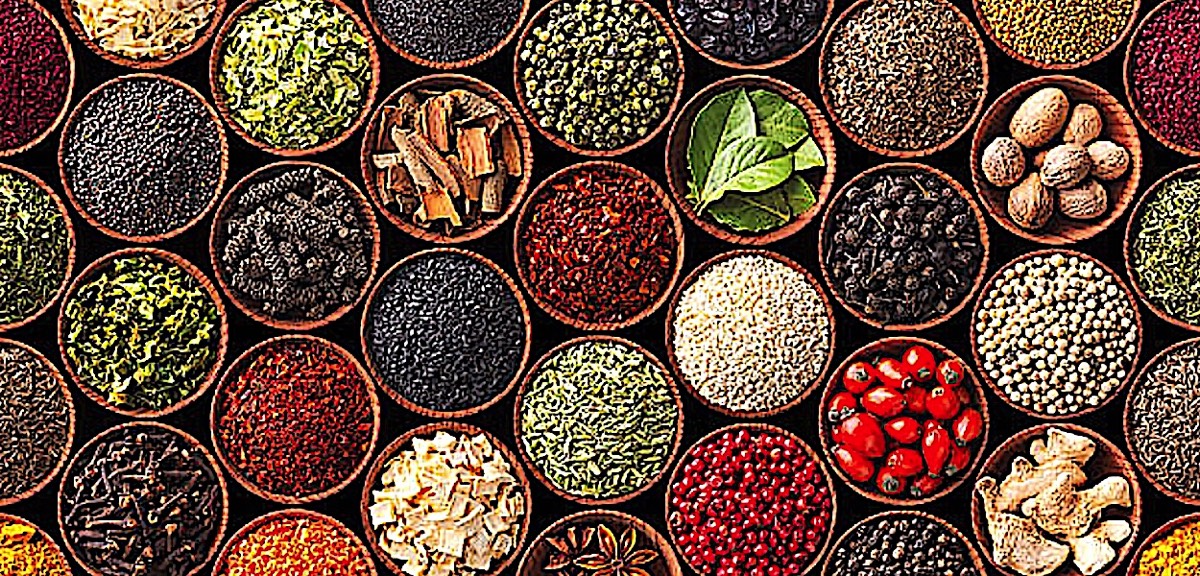

There are many health benefits of herbs and spices, not to mention they improve the taste of so many foods!
HealthyLifeHow.com

Health Benefits of Herbs and Spices
There are many health benefits of herbs and spices, not to mention they improve the taste of so many foods! The problem is, most herbs and spices have been sitting on a grocery store shelf for a long time, and thus they don’t have much nutritional value left.
We recommend growing them yourself whenever possible, but if you can’t, always purchase high quality organic ones.
All spices originate from plants: flowers, fruits, seeds, barks, leaves, and roots. Herbs and spices not only improve the taste of foods, but can help preserve them for longer periods of time. Herbs and Spices have antibacterial and antiviral properties and many are high in B-vitamins and trace minerals.
Most herbs and spices also contain more disease-fighting antioxidants than fruits and vegetables.
We recommend growing them yourself whenever possible, but if you can’t, always purchase high quality organic ones.
All spices originate from plants: flowers, fruits, seeds, barks, leaves, and roots. Herbs and spices not only improve the taste of foods, but can help preserve them for longer periods of time. Herbs and Spices have antibacterial and antiviral properties and many are high in B-vitamins and trace minerals.
Most herbs and spices also contain more disease-fighting antioxidants than fruits and vegetables.
Health Benefits of Herbs

Here is a breakdown of the health benefits of various herbs and spices that you may or may not have around the house.
Cinnamon

Cinnamon has the highest antioxidant value of any spice.
It has been shown to reduce inflammation and lower blood sugar and blood triglyceride levels. Cinnamon has also been used to alleviate nausea and to increase sensitivity to insulin and aid in fat burning. It provides manganese, iron and calcium. It’s antimicrobial properties can help extend the life of foods.
It has been shown to reduce inflammation and lower blood sugar and blood triglyceride levels. Cinnamon has also been used to alleviate nausea and to increase sensitivity to insulin and aid in fat burning. It provides manganese, iron and calcium. It’s antimicrobial properties can help extend the life of foods.
Basil

Basil has anti-inflammatory and antiviral properties and can help prevent osteoarthritis. It has been used in digestive disorders and is being studied for its anti-cancer properties. Though commonly used in Italian cooking, Basil is a versatile herb that can be added to practically anything. Fresh is always best, but dried is ok too as long as it is freshly dried.
Arrowroot

Arrowroot is a starchy herb that I keep on hand, especially since we went gluten free. It has an amazing thickening ability similar to cornstarch, and it can be added to soups, dips, baking etc. Arrowroot can be used in place of flour for a roux or as the main baking ingredient in a gluten-free teething biscuit for kids. It is soothing and highly digestible so it is often used in treatment for conditions like Irritable Bowel Syndrome.
Turmeric

Turmeric contains Curcumin, a cancer-fighting compound. It is more often taken medicinally in America for its ability to reduce inflammation and improve joints. For a spark of flavor, add to egg dishes, soups, meat dishes, sauces and baked foods.
Garlic

Fresh cloves are always best, but powdered, minced and granulated forms provide excellent flavor. This is another one that goes into everything from eggs, to tuna salad, to baked fish for dinner. Studies show that just 2 fresh cloves a week provide anti-cancer benefits.
Cayenne

Cayenne has many health benefits and can improve the absorption of other nutrients in foods. It has been shown to increase circulation and reduce the risk of heart problems.
It is also a great addition to many foods. In small amounts, it can be added to practically any dish, meat, vegetable or sauce. As tolerance to the spicy flavor increases, the amount added can be increased also.
It is also a great addition to many foods. In small amounts, it can be added to practically any dish, meat, vegetable or sauce. As tolerance to the spicy flavor increases, the amount added can be increased also.
Mint

It has traditionally been used to calm digestive troubles and alleviate nausea. Many people enjoy a tea made from peppermint or spearmint leaves, and the volatile oils in both have been used in breath fresheners, toothpastes and chewing gum. Externally, the oil or tea can be used to repel mosquito. This herb is easiest to consume in beverage form, though an adventurous cook could add it to meat dishes or dessert recipes. Herbs like lemon balm, oregano, and marjoram technically belong to the mint family, but due to their pungent flavor, are usually referred to on their own. Speaking of…
Oregano

Oregano is a common ingredient in Italian and Greek cuisine, and they have the right idea! Oregano (and it’s milder cousin, Marjoram) are antiviral, antibacterial, anticancer and antibiotic. It is extremely high in antioxidants and has demonstrated antimicrobial properties against food-borne pathogens like Listeria. Its oil and leaves are used medicinally in treatment of cough, fever, congestion, body ache and illness. Combined with basil, garlic, marjoram, thyme and rosemary, it creates a potent antiviral, anti bacterial, antimicrobial and cancer fighting seasoning blend. It can also be sprinkled on any kind of savory foods. A couple teaspoons added to a soup will help recovery from illness.
Cumin

The second most used herb in the world after black pepper, cumin provides a distinct and pleasant taste. It is most often used in the U.S. in Mexican or Spanish dishes and in seasonings for tacos or chili. I recommend just buying in bulk and using with chili powder to season these dishes. This will provide better flavor and save money. Plus, have you ever read the ingredients in those little seasoning packages? Hello MSG! Cumin has antimicrobial properties and has been used to reduce flatulence. It is a wonderful addition to curry powder or to flavor Mexican or Middle Eastern dishes.
Curry Powder

Another spice mix that is not commonly used in the U.S. but you might have tasted it in Thai dishes is curry. It can have a wide variety of ingredients, but often contains turmeric, coriander, cumin, cinnamon, mustard powder, cayenne, ginger, garlic, nutmeg, fenugreek and a wide variety of peppers. With all these ingredients it has an amazing range of beneficial properties. Curry is an acquired taste, but can be added to meats, stir frys, soups and stews.
Rosemary

Rosemary is a fragrant evergreen herb native to the Mediterranean. It is used as a Culinary Condiment, to make Bodily Perfumes, and for its potential Health Benefits.
HealthyLifeHow.com
Thyme

Thyme is a member of the mint family and contains thymol, a potent antioxidant (and also the potent ingredient in Listerine mouthwash). Water boiled with thyme can be used in homemade spray cleaners and or can be added to bathwater for treatment of wounds. Thyme water can be swished around the mouth for gum infections or for the healing of wounds from teeth removal. Teas made with thyme have been used to treat athletes foot and vaginal yeast infections. Thyme tea can also be taken internally during illness to speed recovery. In foods, it is often used in French cooking (an ingredient in Herbs de Provence) and Italian. Add to any baked dishes at the beginning of cooking, as it slowly releases its benefits.
Moringa

Moringa is a powerhouse of free-radical-fighting,
anti-inflammatory,
and healing compounds that benefit your heart, head, skin, and more.
HealthyLifeHow.com
Herbs & Spices Bottom Line
There are many other beneficial cooking herbs and spices and I hope to write about a majority of them in time. I encourage you to branch out from salt & pepper and try all the wonderful culinary combinations that can be made with these herbs and spices.
Information about Superfoods

Superfood are food that help us to ensures short and long term health and to get a physical body that is strong, flexible and fit through each stage of our lifes.
HealthyLifeHow.com
Follow Us for the latest HEALTH Information and News:


The goal is to ensures short and long term vitality & health and to get a physical body that is strong, flexible and fit through each stage of our lifes.
HealthyLifeHow.com




